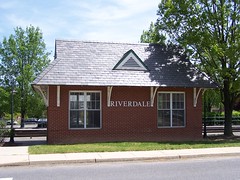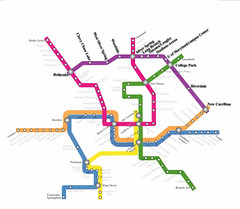Walking Tour: Lessons from the Hyattsville Gateway Arts District
From Lauren O'Connor, Coalition for Smarter Growth:
with Aakash Thakkar, EYA
Dineene O’Connor, Prince George’s County Planning Department
Stuart Eisenberg, Hyattsville Community Development Corporation
Saturday, May 10, 11:00am
Talk and Tour 11:00am – 12:30pm
Informal Lunch 12:30pm - 1:00pm
Meet at EYA Office, 4424 Longfellow St. (Intersection with Rte. 1) in downtown Hyattsville
Buses run from College Park Metro on the Green Line and Rhode Island Ave. on the Red Line. Parking is available across the street.
RSVPs Required: lauren@smartergrowth.net or 202-244-4408 ext. 125
Over the past ten years, the Prince George’s County towns of Mount Rainier, Brentwood, North Brentwood, and Hyattsville pulled together to revitalize their car-dominated main street, Rhode Island Avenue/Route 1. The corridor is becoming a vibrant, pedestrian-oriented place with a lively arts culture.
---------------------
Editor's note: the Gateway Arts District and the Gateway Community Development Corporation are entities separate from the Arts District Hyattsville project discussed below. Separately, the Gateway Arts District Sector Plan helped lead to the development of artist live-work housing that was constructed separately from the Gateway CDC by Artspace of Minneapolis.
The Gateway Arts District is part of a State of Maryland program that designates arts districts across the state (Silver Spring and Bethesda are designated also). This provides certain tax benefits for artists and access to funding for arts-based projects for property owners.
-------------------
Arts District Hyattsville, an EYA residential and retail project, is among the many revitalization efforts in the area. This large new development will provide a mix of rowhomes, live-work homes and lofts, along with shops and galleries.
EYA, a major local builder specializing in walkable, urban development is offering 500 new rowhouses and condominiums plus new retail including a Busboys and Poets restaurant. Join us for a discussion about the Gateway Arts District as a tool for community revitalization and a tour of the emerging EYA rowhouse and main street retail development. The tour will be followed by lunch at Franklin’s Restaurant, Brewery and General Store.
-- Learn more about EYA’s mixed use rowhouse development
----------------
I have a prior commitment otherwise I would probably go just to hear the people speak.
Interestingly enough I think it's a stretch to claim great success on the part of the Arts District thus far, although I think they have a lot of accomplishments, especially given their location without subway transit, and the limited funds at their disposal.
The Gateway Arts District is very successful I think in seeding and supporting artists, such as in the new Brentwood Arts Center and in harvesting the opportunities of railroad-side buildings, one of which now houses the Washington Glass School, which was displaced from DC.
But not in seeding retail. For example, the Artmosphere Cafe has financial difficulties according to the Gazette, in "Artmosphere Digital Café facing financial hardship," and while the Franklin's Restaurant is somewhat successful financially (and I like it ), it's been difficult getting successful retail around it--a gallery and other businesses have failed, although a knitting store seems to be succeeding. And that area enjoys additional traffic not won by typical commercial districts because of civic anchors--the post office, the Hyattsville City Hall, and the nearby County Courthouse.
I think that the EYA development is done very well, but that the specific building type employed at that location--rowhouses--isn't necessarily the right kind of building type for that location, I probably would have favored a multiunit building, condos and/or apartments, given the spatial relationship of that space to the road, and the need to bulk up and create a better "town" center effect for that part of Hyattsville.
(The new housing, regardless, will help attract more residents-consumers to the area, which always helps retail.)
In other words, the New Urbanist transect kind of idea, but the idea here being that housing goes in certain places in certain ways depending on where it is located within a community and the conditions around it.
Illustration from The House Book by Keith DuQuette.
Now it might change a bit as a retail building is constructed across the street--HOWEVER, this building is going to be constructed WITHOUT housing above, wasting an opportunity to add housing, especially affordable housing, and to help to realize a true downtown core in Hyattsville.
This kind of one story building isn't really appropriate to concentrated business districts these days...
Riverdale MARC train station
This is important too, because if, no I am going to say when, the Purple Line is built, there will be a light rail station, as well as the Riverdale MARC train station, within one mile of this location, not to mention that it's an easy bike ride.
An old Purple Line map, source unknown, showing the Riverdale stop.
Plus this statement is a stretch: The corridor is becoming a vibrant, pedestrian-oriented place with a lively arts culture.
Route 1 in Hyattsville is a terrifying place for pedestrians and for bicyclists. I ride on Rte. 1 to go to class at UMD, and once a police car pulled up alongside me and the officer suggested that I ride on the sidewalk to protect myself, given the narrow road and the terrible condition of the pavement.
I think that adding a bunch of people--residents--on foot to that narrow stretch of Rte. 1 unfortunately may endanger even more people. It doesn't appear as if sidewalks have been or will be widened, and it will be impossible to convert the building side lanes on either side of the street to parking, which would provide some level of protection.
SO, I wonder if the CSG tour is going to raise any of these issues. I doubt it... but I still think the tour would be interesting.
Labels: smart growth, sustainable land use and resource planning




0 Comments:
Post a Comment
<< Home